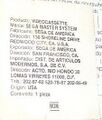Difference between revisions of "History of Sega in Mexico"
From Sega Retro
Lukdriver14 (talk | contribs) |
SEGAAA2004 (talk | contribs) |
||
| Line 24: | Line 24: | ||
== Latam Games == | == Latam Games == | ||
| − | [[Latam Games]] distributes Sega games in Mexico from 2012<ref>http://www.rolagames.com/pressrelease.php</ref>. The company also cooperated with [[NC Games]]<ref>http://www.ncgameslatam.com/sobre-nosotros</ref>. | + | [[Latam Games]] distributes Sega games in Mexico from 2012<ref>http://www.rolagames.com/pressrelease.php</ref>. The company also cooperated with [[NC Games]]<ref>http://www.ncgameslatam.com/sobre-nosotros</ref>. Due to Mexico adapting its rating system in 2021, new and existing SEGA titles were being reprinted with the newly-adapted Mexican rating system in place instead of the ESRB system used in the US and Canada. |
==References== | ==References== | ||
Revision as of 16:00, 17 October 2021

|
| History of Sega in Mexico |
|---|
| Official Sega distributor(s): DISAM S.A. de C.V. (~1990-1995), Sega México (1996-2014) , Latam Games (2012-present) |
This short article is in need of work. You can help Sega Retro by adding to it.
The videogame industry in Mexico is largely unknown, although it began in the mid-1970s and has led to companies like Elpro, Novedades Electronicas S.A with NESA pong consoles created by Mr. Morris Behar considered as the father of videogames in Mexico in that country, based on the pong games of Atari 1972. Also mention to Evoga entertaiment that has collaborated with the development of games for SNK Neo Geo.
However, it is also known that, as in South America, the piracy of video games was very abundant with the NES/Famicom, especially in the early 90s.
Disama S.A. de C.V.
Around 1990, Sega started distributing its consoles through Distribuidora De Articulos Modernos S.A. de C.V. which took the name of Sega De Mexico. Sales of the Sega Master System console began with advertising on TV in American commercials with a Spanish voice by Rubén Moya. The games could be purchased at the Videocentro store, which used the Escuadrón Videocentro Sega slogan in its advertisements. The Genesis, Game Gear, and Master System II were released next. All consoles were imported in the NTSC system. It is worth mentioning that many of the Sega games in Mexican territory were the US versions, however when the Master System arrived, titles in Spanish imported from the PAL versions were also distributed to save costs. In 1992, DISAM sponsored Vídeo Aventuras: Gamesa con Sega.
Sega products did not gain popularity in Mexico. One of the main reasons was competition from Nintendo represented here since 1989 by C. Itoh/Itochu with full support in Club Nintendo magazine. Itochu successfully advertised and sold Nintendo products in Mexico thanks to the low price. The problems with Nintendo in Mexico began with Gamela, which had been a distributor since 1996.[1] Before that, however, Nintendo dominated the Mexican market with Super Nintendo and Genesis was not very popular in that country. Still on the Sega Genesis Mexicans had titles exclusive as Chavez II that included a Spanish translation that was actually the Mexican version of Boxing Legends of the Ring something strange because Chavez II was conducted by the magazine Club Nintendo Mexico who Chavez conducted for Super Nintendo case of competition was the publisher SEGA. DISAM S.A. de C.V. also imported Sega CD and Sega 32X, but in 1995 it went bankrupt.
Sega México
In 1996, Sega of America founded Sega México[2] which was behind the release of Sega Saturn, Sega Dreamcast and other PC games. The last activity of the company was reported in 2014.[3]
Latam Games
Latam Games distributes Sega games in Mexico from 2012[4]. The company also cooperated with NC Games[5]. Due to Mexico adapting its rating system in 2021, new and existing SEGA titles were being reprinted with the newly-adapted Mexican rating system in place instead of the ESRB system used in the US and Canada.
References


